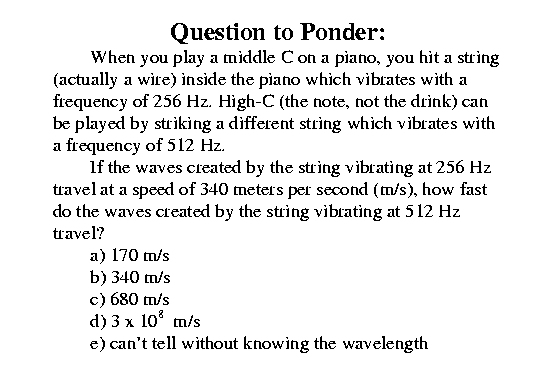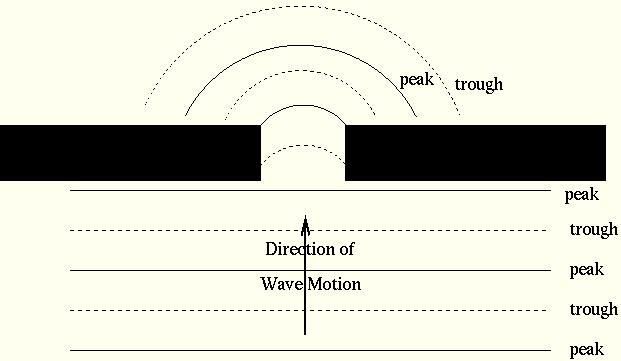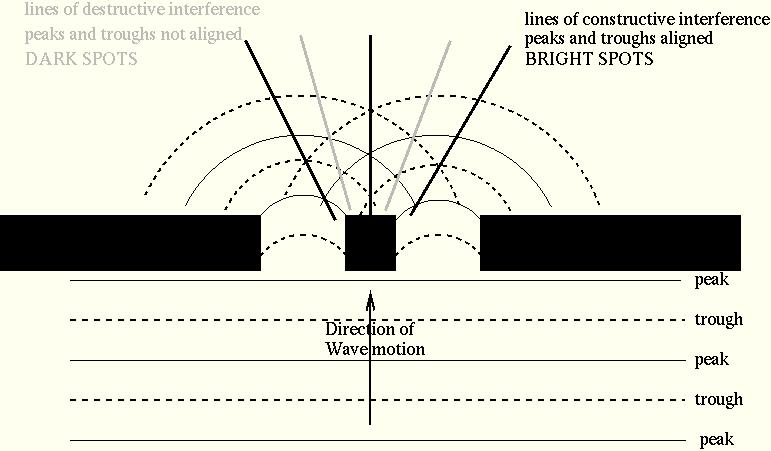|
Much as I venerate the name of Newton, I am not therefore obliged to
believe he was infallible. I see... with regret that he was liable to
err, and that his authority has, perhaps, sometimes even retarded the
progress of science.
Thomas Young (c. 1829), quoted in Mason's A History of the Sciences |
Assignments:Read Chapter 4 in your text
|

In Class:-------------------------------------------------------------- review: waves are the propagation of energy through a medium medium sets the propagation speed - usually has something to do with how well bits of the medium are connected; communication periodic trains of waves can be defined by their frequency,-- number a waves to pass a given point per unit of time number per sec, or /sec , or Hz period, -- time betwen adjacent crests note: period = 1/frequency and by wavelength - distance between crests of a wave Note: wavelength/period = speed we will more often see this as: wavelength x frequency = speed allows for conversion between frequency and wavelength, IF you know the wave speed ------------------------------------------ The real wave phenomenon we're interested in is light Actually, the idea that light is a wave phenomenon is pretty new - Newton firtst showed that white light was a mixture of colored lights - prism (everyone knew that, though <-- New age fairs) - all thought that the prism changed the light didn't just split it up. - Newton showed that the prism could also be used to make white light from the colors - proved that white light really was a mixture - Newton decided that light was a made of elementary colored particles, which traveled through space - explained a lot - prisms split up the particles - light could travel through empty space - light stopped or bounced off objects - however, Newton's corpuscular theory could not explain diffraction and interference. - diffraction you've seen (and heard) - phenomenologically, it's the ability of waves to go around corners - see it in harbors, sometimes - waves, breakwater - waves come in and can wrap around breakwater - essentially, the opening is like a point source because the water is pushed up and down at the opening - NOTE: That's a wave explanation 
- this is what happens with light, too. and it can't be explained by the corpuscular theory - light bullets should just pass through no wrapping around the edges. If that's not bad enough, you've got interference to deal with too. - make a breakwater with two breaks 
- each creates a diffraction pattern
- but a bit downstream, the waves overlap
- start by looking at the line in the center of the pattern
- here, wave peaks from each opening meet at the same
time (cuz they travel the same distance to get here)
- therefore, the combined effect of the waves from both
openings is a really big peak.
- likewise valleys meet at the same time, so the combined
effect is really big valleys.
- result: big amplitude waves
bad place to park your boat.
called CONSTRUCTIVE INTERFERENCE
- now consider one of the grey lines, offset a bit from center
- here, the distance from one opening is shorter than the
distance from the other opening, so wave peaks from both
openings DON'T arrive at the same time
- instead, a wave peak from one opening arrives at the
same time as a valley from the other opening.
- when the waves combine, result is nothing.
- later when a valley from one opening combined with a peak
frmo the other, still nothing.
- result: no waves here.
good place to park your boat.
called DESTRUCTIVE INTERFERENCE
- If light is a wave, then places where there's constructive
interference (big amplitude waves) are bright, and places where there
destructive interference (zero amplitude waves) are dark.
- again, it's really impossible to make interference happen if light is
particulate
- what would you see behind two slits? -- two points of light.
It really wasn't until the 1820's that people confronted this evidence
that light was wavelike
- probably partly because of Newton's stature
science is funny that way
The above two-slit experiment was conducted by Thomas Young in 1829
and showed that light really needed to be a wave.
take two slits:
- illuminate them
- should see a pattern of light and dark "fringes"
--> doesn't work
- so light isn't a wave
- that's what others said
- but Th. Young thought otherwise
- if the slits are too large, or too far apart
- no interference
- what means too large, or too far apart
- compared to the wavelength of the wave
- when he tried with smaller slits more closely spaced
- he saw the pattern of dark and light
Young discovered not only that light was a wave but that the wavelength of
visible light is really small.
Furthermore, the colors of light correspond to specific wavelengths
- the angle at which constructive interference occurs is dependent
on the wavelength of the light
- so different wavelength light will produce a wider or narrower
fringe pattern.
- Thomas Young used the fringe spacing, and the distance
between his slits to measure the wavelength of light
-- very small; less than a millionth of a meter
ranges from 400nm to 700 nm (nm = 10^-9)
blue to red
Because the angle of constructive interference depends on wavelength,
a two-slit interference pattern of white light looks like a rainbow
- diffraction gratings (which probably should be called interference
gratings) are glass with thousands of tiny lines ruled on them
- each pair of lines creates a tiny slit, and light from
adjacent slits interferes to produce Young's pattern.
take a look
So,
light must be a wave
- diffraction, interference
colors correspond to wavelengths of light
- really small
- blue = 400 nm
- red = 700 nm
--> what about longer wavelengths or shorter wavelengths?
- what's so special about 400-700 nm?
- absolutely nothing (except we can't see other
wavelengths of light)
- light can have any wavelength at all
- long wavelength light --> radio waves -- meters in size
- short wavelength light --> x-ray -- atomic sizes
- light is nothing more than a wave
- visible light is a wave of special wavelengths that we
can see
- all light waves move at the same speed
- radio waves, xrays, visible light
- it's only their wavelength (and frequency, of course)
that differ.
- we'll see next time that different wavelengths of light can give
us different information about the universe,
mainly because of the different ways light is produced.
|
![]()